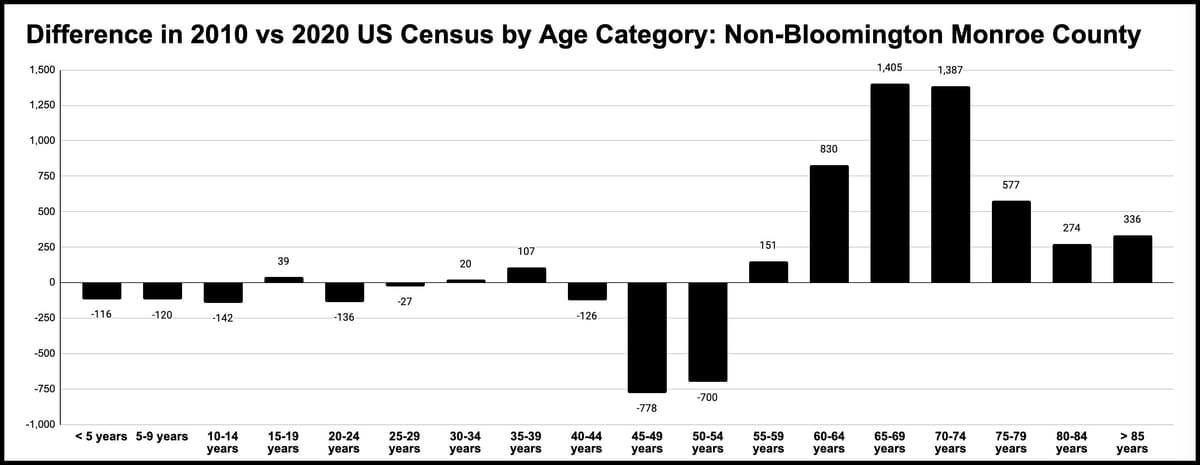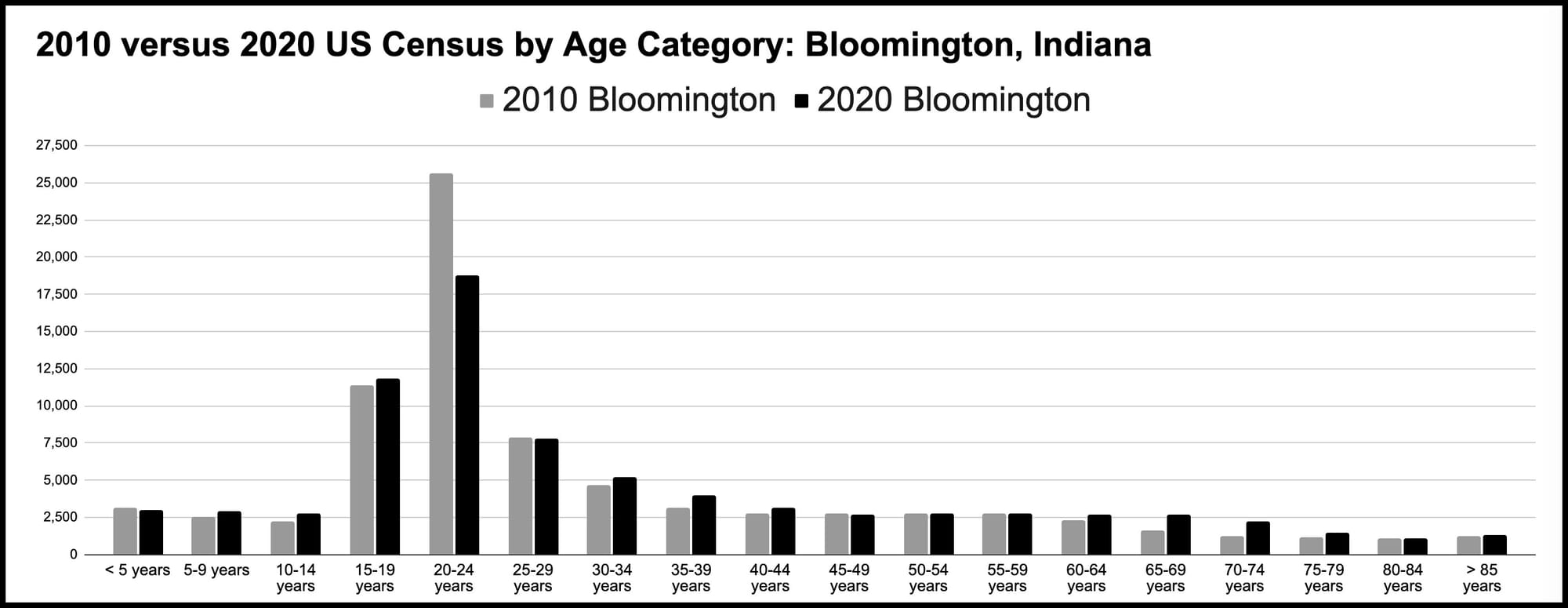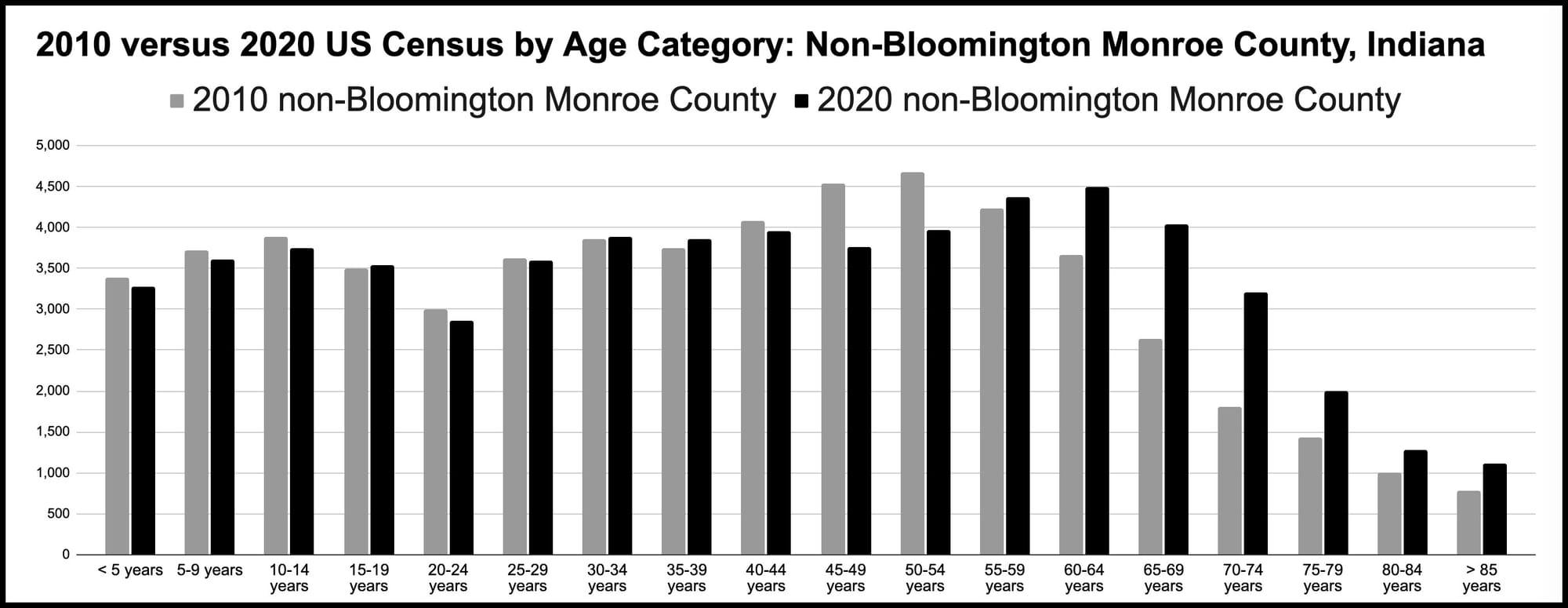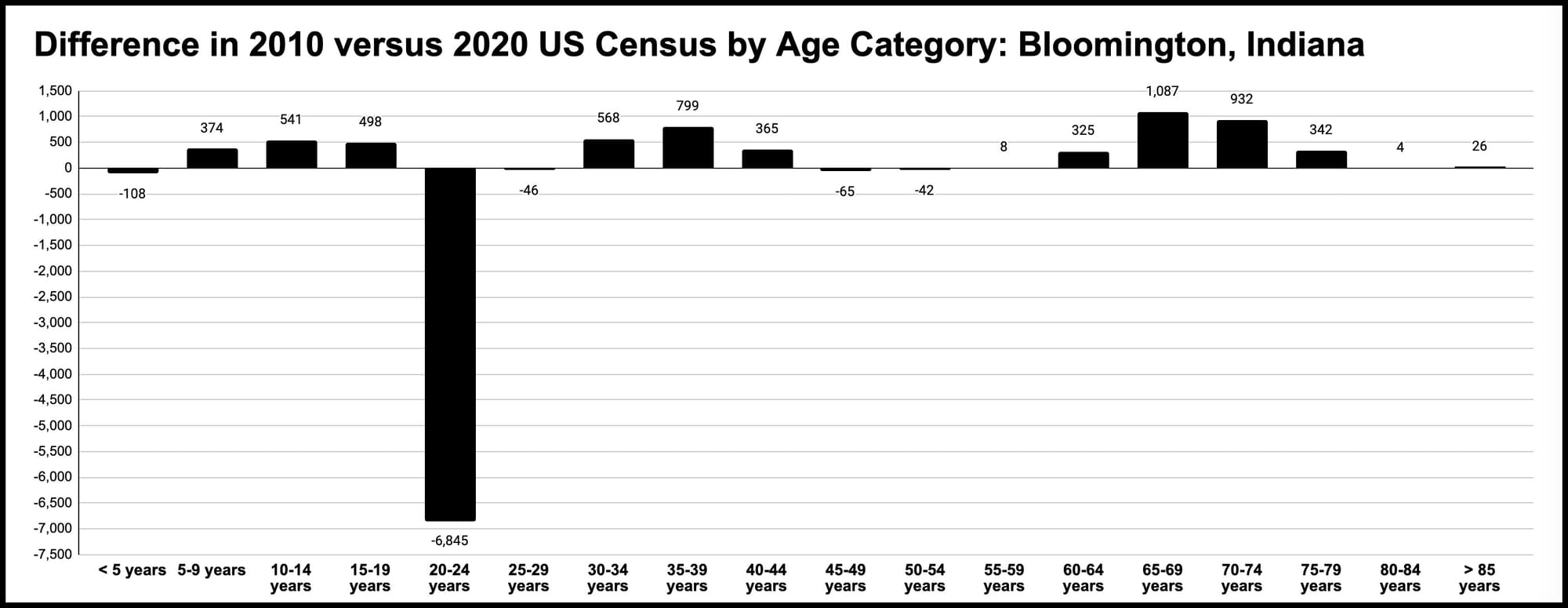Monroe County losing 45-54-year-olds, adding seniors


In 2010, the fraction of Monroe County’s population that was older than 65 was about 10.1 percent.
By 2020, the fraction of 65-and-older residents had grown by about 4.5 points, to 14.6 percent.
Those are figures based on numbers from the decennial census conducted by the US Census Bureau.
Within easy reach as a possible explanation for the countywide trend might be the likely undercount of college-age students inside the city of Bloomington.
In Bloomington, between 2010 and 2020, the census measured a decrease in the 20-24 age bracket by 6,845 (27 percent), from 25,610 to 18,765—a pattern likely caused at least in part by the COVID-19 pandemic.
But in the part of Monroe County outside the city of Bloomington, the 65-and-older segment showed even bigger growth than in the county overall.
In non-Bloomington Monroe County, the percentage of the 65-and-older age group grew as a fraction of the population, from 13.3 percent to 19.2 percent, for a 6-point gain.
In non-Bloomington Monroe County, the increase in the 65-and-older population was accompanied by a significant loss in population for the 45-54 age bracket—which is a range that includes experienced, mid-career workers. From 2010 to 2020, the non-Bloomington part of Monroe County lost 1,478 people in the 45-54 age bracket.
Without the growth in the number of 65-and-older residents, the non-Bloomington population of Monroe County would have decreased by about 1,000 people between 2010 and 2020. The under-65 population in non-Bloomington Monroe County dropped from 49,907 in 2010 to 48,909 in 2020.
In percentage growth and loss terms, the 65-and-older non-Bloomington Monroe County population grew from 11,327 to 16,136 for a 42.5-percent increase.
In non-Bloomington Monroe County, the 45-54 population dropped from 9,209 to 7,731 for a 16-percent decrease.
Inside Bloomington, the same pattern can be seen—gains in the older age brackets but loss in the prime working age-group—even if it is not as stark as in the area outside Bloomington.




The pattern of loss in the 45-54 age bracket is something that needs to be addressed, according to John Fernandez, who is now senior vice president for innovation and strategic partnerships at The Mill. Fernandez served as assistant secretary of commerce for economic development in the Obama administration, and is a former mayor of Bloomington.
Reacting to the figures provided by The B Square, Fernandez wrote in an email: “If the ‘qualified workforce’ supply is not increasing at pace with employers’ requirements, companies go / grow elsewhere and this creates an economic decline that in turn creates financial constraints that negatively impacts the delivery of quality local services.”
Fernandez continued, “As quality of life declines, talent leaves and / or is harder to recruit. This becomes a problematic downward spiral that is extremely difficult to reverse.”
On the general topic, Fernandez recommended a book by Martin Lautman: “When the Boomers Bail—How Demographics will Sort Communities into Winners and Losers.”
Fernandez concluded: “Bloomington / Monroe County, in my view, is at a tipping point. We need to address these population issues head on.”
Concurring with Fernandez was Eric Spoonmore, who is CEO of the Greater Bloomington Chamber of Commerce. Reached by phone, Spoonmore said that the numbers show that even though the population overall is growing, those segments crucial to economic development are not showing the kind of growth that is needed.
Spoonmore is a former member of the Monroe County council, which plays a role in the enactment of local income taxes, even if it is the Bloomington city council that can, under state law, unilaterally enact local income taxes for all county residents.
Spoonmore told The B Square that local government has become increasingly dependent on local income taxes, pointing specifically to the enactment of the public safety local income tax (0.25 percent) and the economic development local income tax (0.69 percent) in recent years.
Possibly soon to be added to the mix might be a local income tax specifically for the new county jail. Some current county councilors have acknowledged to The B Square that in order to pay for the kind of new co-located facility—including space for courts, prosecutors and public defenders—which many hope to see built, it’s virtually certain that a new jail income tax would be needed.
Spoonmore said that if the community is increasingly going to rely on local income taxes to fund local government, then the segment of the population that pays significant local income taxes needs to grow—and that segment is workers in their prime years.
But based on the numbers in the charts, Spoonmore said, instead of growing that segment, “We’re losing that age segment of the population.” Spoonmore said, “That spells, I think, a lot of trouble long term for the community. So it’s very concerning for me.”
Area 10 Agency on Aging executive Chris Myers was not surprised by the numbers, writing in an email to The B Square: “[W]e’ve been seeing the shift in population happening for many years now.”
The gains in the older age brackets Myers attributed at least in part to the natural aging of the population. What’s not happening, Myers wrote, is the “equal retention of the younger ages.”
As far as Area 10 goes, Myers wrote, “We’ve definitely witnessed the increase in need for support of older adults in the past 5+ years.” Myers added, “Unfortunately, funding has not shifted to reflect the increasing pace of the Baby Boomer generation aging.”
Myers pointed to transit-specific issues, which have been highlighted recently in Monroe County, as the new enforcement of existing federal rules has prevented Area 10’s Rural Transit from using federal funds to make trips within both origin and destination within the “urbanized area” of the county.
“We know that there is an increased need for safe, reliable transportation for our aging neighbors,” Myers wrote. She continued: “This is why increased demand response (or door to door) service is needed in the county.”




Comments ()